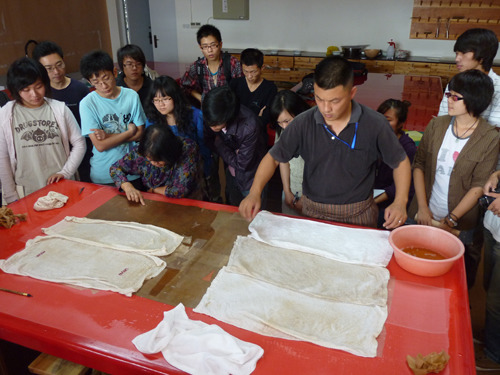(Ecns.cn)--After more than a year of trial restoration work, China's Central Academy of Fine Arts (CAFA) has finished repairing more than 50 traditional Chinese paintings and oil paintings. In order to arouse public attention to the protection of the fragile paintings, the academy opened an exhibition for the works on Nov. 11, 2011.
"Many art galleries nowadays are not conscious of protecting and repairing their own collections, which should be their priority task. And galleries should also introduce the restoration process to visitors as an important way to protect artwork," said Wang Huangsheng, director of the CAFA art gallery.
Starting from April 2010, CAFA ignited a new round of painting restoration. At the current exhibition, the results of their labors have been displayed to let viewers judge whether the job done by the artists is satisfactory.
China has a long history of restoration of traditional paintings and calligraphy works. Picture mounting – one of the aspects of restoration – and traditional painting and calligraphy can be traced back to 2,000 years ago.
Feng Pengsheng, a famous artist known for painting restoration, once presided over the repair of a painting by Ding Guanpeng, a painter from the Qing dynasty. The work was collected in Germany, but because of its improper preservation it became in huge demand.
The German embassy found Feng and asked him to repair the work. The painting is nearly 50 square meters with heavy colors and golden contour lines, but because of humid weather and dust, the painting had become very brittle. That's when Feng and his colleagues took two years to return the painting to its former glory.
Compared with the knowledge and techniques used to restore traditional paintings, the experience of oil painting restoration is not as mature here. Oil painting has a history of little more 100 years in China, and Chinese artists are still learning to do a better job.
"The materials for oil painting and the restoration techniques in China lag behind its foreign counterparts, and since no good protection measures were taken to protect the paintings, some oil paintings finished during the 'Cultural Revolution' are in poor condition," added Wang.
Wang started to pay attention to painting restoration while he was still working at the Guangdong Art Gallery. From 1998 till now, he has organized the restoration work for many galleries.
"It is necessary that we attach more importance to the repair work of paintings," said Wang.
At the exhibition, the most difficult oil painting to repair is by modern Chinese oil painter Wang Shaoling. Xu Yan spent a whole month on the work, where "every procedure you took to repair the work needed to be very careful," said Xu. "It had been oxidized badly, and I took a photo of it to help work out a repair plan."
The job of repairing a painting requires an artist to be very patient and responsible to do the job well. "Repairing a painting is a way to help increase the life of a work," said Feng.
Right now in China, there are millions of works needing to be saved. Many have been left behind in museum storage, ruined by time and weather. Artists like Wang and Feng are eager to repair them, but the situation is awkward.
Basically, there are two types of repairs. One seeks to retain the work's historical look, which means that the artist just cleans the painting, but does not add other materials to it; the other is to replenish the painting. If some parts have disappeared, for example, the artists may add to it to return the work to its former glory.
Cleaning a work is easier, but to return a work to its original state is not a simple task. In 2005, the Imperial Palace tried to repair the famous picture "Riverside Scene at Qingming Festival." Because they had to remove a small part of the silk, the art circle raised doubts about the restoration.
"What the Imperial Palace did was a failure of restoration, but due to a lack of techniques and other reasons, the repair work became more difficult," said Feng. "Combining modern technology with experienced repairers would be an ideal way to restore the work," said a professor form the Beijing University of Aeronautics and Astronautics.
Besides lacking technology, the decreasing number of repairers is another problem. "People right now are focused more on the economy and they can't stop to learn other skills. Some government officials do care about the job, but when it comes to other folks, things are different," said Feng.
Wang has been organizing painting restorations for over 10 years, but now there are only four people left in his studio continuing the job. "Now in China, people who are capable of repairing national level paintings are rare," said Feng.
Wang hopes to attract attention from students through the exhibition at the academy, but the result has not been good so far. Not many have come to see the displays, but Wang hopes that more will come as the exhibition continues.


















